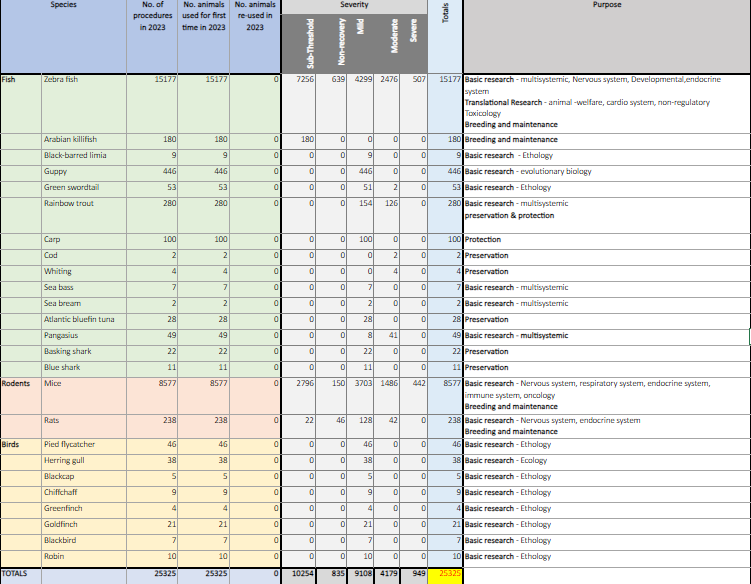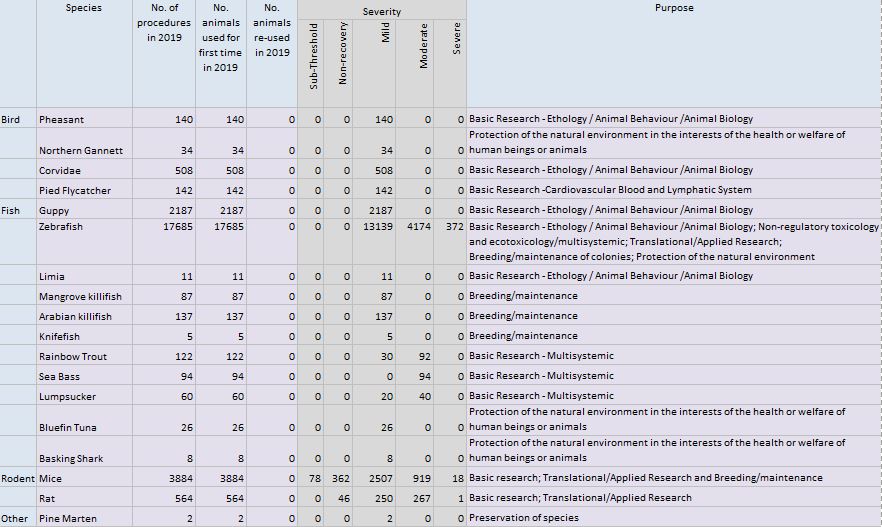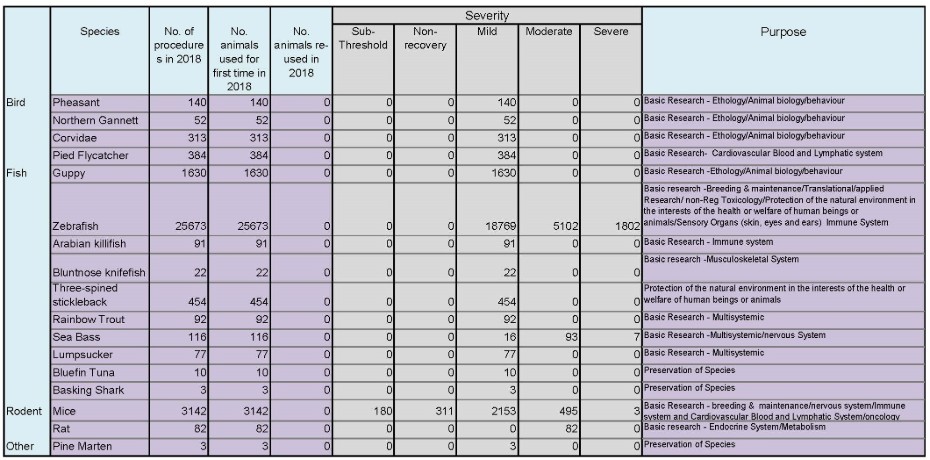Frequently asked questions
Why do you still research using animals?
In a university where biological sciences and medicine have a high profile, such as the University of Exeter, animals are sometimes necessary for research and teaching. Until satisfactory alternatives have been developed, the processes of discovery, enquiry and teaching require approaches that involve animals in order to gain a knowledge and understanding of molecular biology, ecology, behaviour, physiology and pathology, and in order to pass on that knowledge to students.
Scientists at the University of Exeter, in common with many other researchers, are constantly seeking ways to reduce the number of animals needed for research and teaching; refining experimental methods, and replacing animals wherever possible, working to the exacting requirements of the Home Office and funding agencies.
However, ‘alternative’ tests and models have yet to be developed that can properly reproduce the complex biological characteristics of humans and animals, and studies of wild animals in their natural environment will always require the involvement of the animals themselves.
Why aren’t there alternative research methods?
There are very many non-animal research methods, all of which are used at the University of Exeter. These include research using human participants, computer models and simulations, and statistical modelling.
By law, non-animal research methods must be used wherever possible. For many projects, of course, this will mean no animals are needed at all. For others, there will be an element of the research which is essential and for which there is no alternative means of obtaining the relevant information.
Which species of animals are involved in what type of research at the University of Exeter?
We proud to say that we are home to world leading research in ecology, which involves a lot of working in the field with wildlife to support the global conservation efforts. This, alongside work in the aquariums, covers the majority of the research that we do with animals. Examples of the types of research include the impacts of microplastics, pollution and whale/shark migration as well as understanding the migration of songbirds. Our wildlife work is all for conservation, and usually involves only observation and tracking.
We are fortunate to be working in an environment in the UK that is the most highly regulated in the world where animal research is concerned. This means every animal used will be treated according to the highest welfare standards, and only used where absolutely necessary.
Exeter goes above and beyond the UKs requirement on care and welfare for animals involved in research – in line with our institutional culture and our values of respect and excellence. These values are upheld by all our staff and put into practice by those who care for the animals in the units.
We ensure animals have extra handling and care, we use rat ‘playpens’ to allow animals to interact with each other and the animal care staff. We ensure all animals have access to enrichment in their housing, to allow natural behaviours as much as possible. We have strictly limited any animal work to research that fulfils the University strategic vision to be fairer, greener, healthier. This includes limiting the number of species we use in medical research to fish and rodents.
Within our animal work we:
- Commit to improving animal welfare, scientific quality (to ensure all the work we do on animals is effective), care of staff and transparency to stakeholders.
- Uphold the 3R principles: Reduction: of all animal work and numbers, Replacement: of any animal we can in research, for example Galleria moth larvae. And Refinement: all our work considers refinement at every level. This is entrenched in all our work, and we have dedicated meetings and discussions monthly explore these 3Rs, and track gains and next steps consistently.
- Commit to upholding the highest possible health status and an outstanding culture of care- we do this well beyond our legal requirement.
How many animals do we use?
Please see below the number of animals (by species) used per year in our research and for what purpose as defined by the Home Office. These include:
Basic research includes studies of a fundamental nature, including physiology. Studies that are designed to add knowledge about the normal and abnormal structure, functioning and behaviour of living organisms and the environment.
Translational/applied research includes discovery toxicology, investigations prior to formal regulatory studies and method development. It includes efficacy testing during the development of new medicinal products. It does not include studies required for regulatory submissions.
Protection of the natural environment in the interests of the health or welfare of human beings or animals. This includes studies aimed at investigating and understanding phenomena such as environmental pollution, loss of biodiversity and epidemiology studies in wild animals. This excludes the regulatory use of animals used for ecotoxicology purposes.
Preservation of species. This includes research where the primary purpose is the preservation of a species e.g., vulnerable, or endangered wild animals.
Breeding / maintenance of colonies of established genetically altered animals, not used in other procedures.
In 2023, 25325 animals were used for research at the University of Exeter. Some of these animals were housed at the University, and some were observed in the field.

In 2022, 15672 animals were used for research at the University of Exeter. Some of these animals were housed at the University, and some were observed in the field.

In 2021, 17338 animals were used for research at the University of Exeter. Some of these animals were housed at the University, and some were observed in the field.
In 2020, 18008 animals were used for research at the University of Exeter. Some of these animals were housed at the University, and some were observed in the field
In 2019, 25696 animals were used for research at the University of Exeter. Some of these animals were housed at the University, and some were observed in the field.

In 2018, 32284 animals were used for research at the University of Exeter. Some of these animals were housed at the University, and some were observed in the field

In 2017, 27237 animals were used for research at the University of Exeter. Some of these animals were housed at the University, and some were observed in the field.
| Species | No. of procedures in 2017 | No. animals used in 2017 |
| Pheasant | 200 | 200 |
| Northern Gannett | 61 | 61 |
| Corvidae |
356 | 356 |
| Pied Flycatcher | 217 | 217 |
| Guppy | 959 | 959 |
| Zebra Fish | 22144 | 22144 |
| Three Spined Stickleback | 909 | 909 |
| Swordtail | 9 | 9 |
| Fathead Minnow | 760 | 760 |
| Hump-backed Limia | 10 | 10 |
| Rainbow Trout | 174 | 174 |
| Sea Bass | 8 | 8 |
| Red Tail Splitfin | 3 | 3 |
| Basking Shark | 3 | 3 |
| Mice | 1308 | 1308 |
| Rat | 50 | 50 |
| Pine Marten | 12 | 12 |
| Bats | 54 | 54 |
| TOTAL | 27237 | 27237 |
In 2016, 30441 animals were used for research at the University of Exeter. Some of these animals were housed at the University, and some were observed in the field.
| Species | No. of procedures in 2016 | No. animals used in 2016 |
| Pheasant | 200 | 200 |
| Northern Gannett | 64 | 64 |
| Corvidae | 354 | 306 |
| Pied Flycatcher | 353 | 353 |
| Blue Tit | 269 | 269 |
| Guppy | 1118 | 1118 |
| Zebra Fish | 24813 | 24813 |
| Stickleback | 1967 | 1967 |
| Swordtail | 45 | 45 |
| Humpbacked limia | 5 | 5 |
| Redtail splitfin | 1 | 1 |
| Brown Knifefish | 6 | 0 |
| Rainbow Trout | 286 | 286 |
| Southern Platyfish | 74 | 74 |
| Basking Shark | 3 | 3 |
| Mouse | 608 | 608 |
| Hazel Dormouse | 32 | 32 |
| Grey Squirrel | 48 | 48 |
| Pine Marten | 21 | 21 |
| Polecat | 6 | 6 |
| Bats | 168 | 168 |
| Total | 30441 | 30393 |
In 2015, 11905 animals were used for research at the University of Exeter. Some of these animals were housed at the University, and some were observed in the field.
| Species | No. of procedures in 2015 | No. of animals used in 2015 |
| Pheasant | 200 | 200 |
| Northern Gannett | 60 | 60 |
| Corvidae | 384 | 384 |
| Pied Flycatcher | 316 | 316 |
| Common Buzzard | 45 | 45 |
| Blue Tit | 242 | 242 |
| Brent Goose | 71 | 71 |
| Guppy | 786 | 786 |
| Zebra Fish | 7132 | 7132 |
| Stickleback | 929 | 929 |
| Swordtail | 6 | 6 |
| Rainbow Trout | 168 | 168 |
| Brown Trout | 209 | 209 |
| Roach | 371 | 371 |
| Mangrove Killifish | 30 | 30 |
| Southern Platyfish | 14 | 14 |
| Basking Shark | 5 | 5 |
| Mouse | 821 | 821 |
| Hazel Dormouse | 21 | 21 |
| Grey Squirrel | 64 | 64 |
| Pine Marten | 31 | 31 |
| Total | 11905 | 11905 |
In 2014, 17823 animals were used for research at the University of Exeter. Some of these animals were housed at the University, and some were observed in the field.
| Species | No. of procedures in 2014 | No. of animals used in 2014 |
| Pheasant | 284 | 284 |
| Northern Gannett | 63 | 63 |
| Corvidae | 284 | 284 |
| Pied Flycatcher | 103 | 103 |
| Guppy | 784 | 784 |
| Zebra Fish | 13522 | 13522 |
| Stickleback | 411 | 411 |
| Nile Tilapia | 10 | 10 |
| Flounder | 39 | 39 |
| Rainbow Trout | 76 | 76 |
| Sea Bass | 369 | 369 |
| Turbot | 10 | 10 |
| Shanny | 29 | 29 |
| Roach | 432 | 432 |
| Goldsinny Wrasse | 30 | 30 |
| Splitfin Goodeid | 758 | 758 |
| Mouse | 540 | 540 |
| Basking Shark | 10 | 10 |
| Bat | 69 | 69 |
| Total | 17823 | 17823 |
